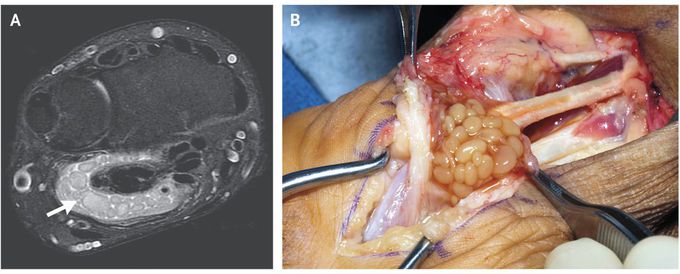


Tenosynovitis Due to Mycobacterium avium Complex
A 51-year-old right-handed man presented to the clinic with a 3-year history of worsening swelling of the left wrist associated with pain and numbness in the fingers. His medical history included type 2 diabetes and human immunodeficiency virus infection; he was adherent to an antiretroviral therapy regimen and his CD4 cell count was 357 per cubic millimeter. He reported no previous trauma or surgeries to the hand. Physical examination was notable for purplish discoloration over the palmar aspect of the left hand. He had pain and an extension deficit in the proximal interphalangeal joint in all four fingers. Magnetic resonance imaging (MRI) revealed multiple loose bodies (“rice bodies”) in an ulnar bursal fluid collection on the volar side of the left wrist (Panel A, arrow). The patient underwent a radical tenosynovectomy, during which soft-tissue masses corresponding to the rice bodies identified on MRI were seen (Panel B). These soft-tissue masses are accumulations of fibrin, collagen, and cell debris resulting from synovial degeneration. Histologic analysis revealed granulomatous tenosynovitis, and mycobacterial culture confirmed invasive mycobacterial tenosynovitis due to Mycobacterium avium complex. The patient was treated with rifabutin, ethambutol, and clarithromycin; the medication regimen was discontinued after 3 months because of side effects. There was no evidence of recurrence at 5-year follow-up.

